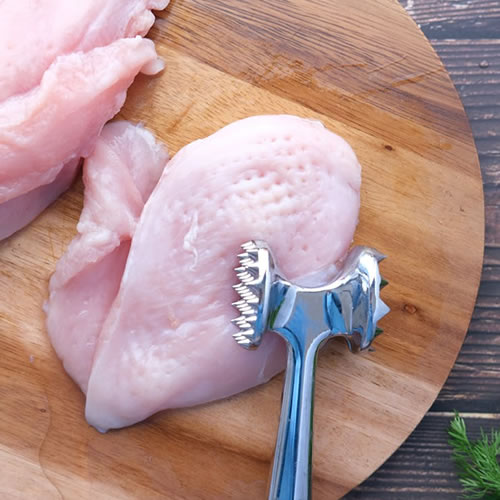Tenderizer Guide
When it comes to cooking meat, tenderness plays a vital role in creating a mouthwatering culinary experience. Tough cuts of meat can become tender and succulent with the right technique. Enter meat tenderizers – the secret weapon to achieve tender, flavorful results. In this buying guide, we'll explore the different types of meat tenderizers available on the market and help you choose the perfect one for your needs.
Types of Meat Tenderizers
 Blade Tenderizers: These mechanical tenderizers feature sharp blades that penetrate the meat, breaking down the tough muscle fibers. They come in manual and electric variants, with adjustable blade depth for customized tenderness. Blade tenderizers are ideal for larger cuts of meat like steaks and roasts.
Blade Tenderizers: These mechanical tenderizers feature sharp blades that penetrate the meat, breaking down the tough muscle fibers. They come in manual and electric variants, with adjustable blade depth for customized tenderness. Blade tenderizers are ideal for larger cuts of meat like steaks and roasts.
Needle Tenderizers: Needle tenderizers use a series of thin, sharp needles to puncture the meat, creating microchannels that promote even marinating and tenderization. They are great for smaller cuts and are often more compact and easier to handle. Look for needle tenderizers with a sufficient number of needles and easy-to-clean designs.
Mallet Tenderizers: Pound the meat with a meat mallet to break down the muscle fibers and tenderize it. This method works well for thick cuts and is often used for dishes like schnitzels or pounded chicken breasts.
Marinating Tenderizers: Marinating is a classic technique that involves soaking the meat in a flavorful liquid to impart tenderness and enhance taste. Create your own marinades using ingredients like citrus juice, vinegar, or yogurt, which contain natural tenderizing properties. Consider marinating techniques like vacuum marination or brining for maximum effectiveness.
Enzymatic Tenderizers: Enzymatic tenderizers utilize natural enzymes, such as papain or bromelain, to break down proteins in the meat, resulting in enhanced tenderness. These tenderizers are available as powders or liquid marinades. Follow the instructions carefully to avoid over-tenderizing, and be mindful of any allergies or sensitivities.
Factors to Consider
A. Meat Types: While all meats can benefit from tenderizing, some cuts are naturally tougher and require more attention. Consider tenderizing techniques for cuts like flank steak, skirt steak, or round roasts to achieve optimal tenderness.
B. Usage and Convenience: Evaluate your usage patterns and convenience preferences. If you frequently cook large cuts of meat, a blade tenderizer might be more suitable. If you prefer a compact and easy-to-use option, a needle tenderizer or a chemical tenderizer could be a better fit.
C. Safety and Maintenance: Mechanical tenderizers with blades require caution during use. Opt for models with safety mechanisms to prevent accidents. Additionally, consider the ease of cleaning and maintenance for both mechanical and chemical tenderizers.
In conclusion, choosing the right meat tenderizer can transform ordinary cuts of meat into extraordinary culinary delights. Consider your specific needs, meat types, and preferred usage patterns when selecting a tenderizer. Whether you opt for a mechanical blade or
